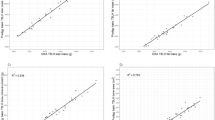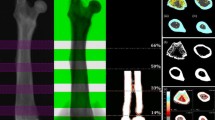Abstract
We investigated the reproducibility of total and regional body composition measurements performed on a dual energy X-ray absorptiometer (DXA). A group of 38 women aged 21–81 (mean 52. 4) years was scanned twice with repositioning to determine intra-observer reproducibility of measurements of bone mineral density (BMD, g · cm−2), bone mineral content (BMC, g), lean mass (LM, kg) and fat mass (FM, kg) of the total body and of the major subregions of the body. In addition, the ability of the DXA machine to detect changes in LM and FM (simulated by placing 11.1 and 22.3 kg porcine lard on the body of 11 subjects) was examined. Coefficients of variations calculated from the root mean square averages of individual standard deviations were as follows (BMD, BMC, FM, LM): 1.4%, 1.1%, 1.4%, 1.7% (total body), 2.2%, 2.1%,-,- (head), 2.8%, 2.8%, 2.0%, 2.2% (trunk), 3.6%, 3.9%, 4.0%, 4.9% (arms), 2.7%, 1.3%, 2.6%, 2.8% (legs). Percentage fat (%fat) of exogenous lard was 81.3 (SD 3.5)% as assessed by the absorptiometer which corresponded well with the result of chemical analysis (82.8%). Estimated %fat of exogenous lard was not influenced by initial body mass or percentage body fat. Percentages of expected mean values with 11.1 kg lard placed on the body were 99.9 (SD 0.3) for body mass, 100.5 (SD 2.1) for LM, and 99.5 (SD 3.5) for FM. BMD was overestimated by 3.2% (P < 0.005) with 11.1 kg lard on the body. BMD as well as BMC increased significantly with 22.3␣kg lard on the body (P < 0.005). The results showed that BMD, BMC, LM, and FM of the total body were precisely estimated by the DXA machine used. Regional measurements were less precise. Changes in total body soft tissue composition were precisely and accurately estimated. The lard placed on the body falsely affected BMD and BMC measurements. Changes in body mass could have a similar effect.
Similar content being viewed by others
Author information
Authors and Affiliations
Additional information
Accepted: 6 January 1997
Rights and permissions
About this article
Cite this article
Madsen, O., Jensen, JE. & Sørensen, O. Validation of a dual energy X-ray absorptiometer: measurement of bone mass and soft tissue composition. Eur J Appl Physiol 75, 554–558 (1997). https://doi.org/10.1007/s004210050204
Issue Date:
DOI: https://doi.org/10.1007/s004210050204




